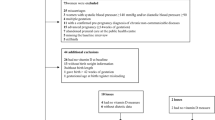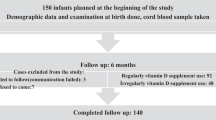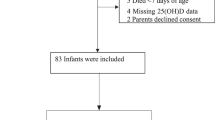Abstract
Objective:
With vitamin D deficiency as a serious public health problem, vitamin D status at birth was measured in neonates at latitude 32°72′ (southeastern United States).
Study Design:
In umbilical cord blood, vitamin D status, demonstrated by circulating 25-hydroxyvitamin D, was measured and related to race and season of birth.
Result:
The mean±standard deviation of 25-hydroxyvitamin D in 100 cord blood samples was 13.5±8.3 ng/ml for the cohort. African-American infants, with a mean±standard deviation of 10.5±6.0 ng/ml, demonstrated significantly lower vitamin D status than Caucasian infants, with a mean±standard deviation of 19.5±9.6 ng/ml (P<0.0001). By season, the mean 25-hydroxyvitamin D level at birth in November–March compared to April–October was 11.3 ng/ml lower in Caucasian infants (from 29.0 to 17.7 ng/ml) and 3 ng/ml lower in African-American infants (from 13.1 to 10.1 ng/ml).
Conclusion:
The prevalence of vitamin D insufficiency is high in this cohort. African-American infants demonstrate significantly lower vitamin D status at birth than Caucasian infants. Seasonality, while significant in both groups, had a greater impact on the vitamin D status of Caucasian newborns.
This is a preview of subscription content, access via your institution
Access options
Subscribe to this journal
Receive 12 print issues and online access
$259.00 per year
only $21.58 per issue
Buy this article
- Purchase on Springer Link
- Instant access to full article PDF
Prices may be subject to local taxes which are calculated during checkout
Similar content being viewed by others
References
Weisburg P, Scanlon KS, Li R, Cogswell ME . Nutritional rickets among children in the United States: review of cases reported between 1986 and 2003. Am J Clin Nutr 2004; 80 (Suppl): 1697S–1705S.
Tomashek KM, Nesby S, Scanlon KS, Cogswell ME, Powell KE, Parashar UD et al. Nutritional rickets in Georgia. Pediatrics 2001; 107: e45.
Kreiter SR, Schwartz RP, Kirkman HN, Charlton PA, Calikoglu AS, Davenport ML . Nutritional rickets in African American breast-fed infants. J Pediatr 200; 137: 153–157.
Shah M, Salhab N, Patterson D, Seikaly MG . Nutritional rickets still afflict children in North Texas. Texas Med 2000; 90: 64–68.
Bhowmick SK, Johnson KR, Rettig KR . Rickets caused by vitamin D deficiency in breast-fed infants in the southern United States. Am J Dis Child 1991; 145: 127–130.
Gartner LM, Greer FR . Prevention of rickets and vitamin D deficiency: new guidelines for vitamin D intake. Pediatrics 2003; 111: 908–910.
Holick MF . Resurrection of vitamin D deficiency and rickets. J Clin Invest 2006; 116: 2062–2072.
Lee JM, Smith JR, Philipp BL, Chen TC, Mathieu J, Holick MF . Vitamin D deficiency in a healthy group of mothers and newborn infants. Clin Pediatr 2007; 46: 42–44.
Ward LM . Vitamin D deficiency in the 21st century: a persistent problem among Canadian infants and mothers. CMAJ 2005; 172: 769–770.
Thomson K, Morley R, Grover SR, Zacharin MR . Postnatal evaluation of vitamin D and bone health in women who were vitamin D-deficient in pregnancy, and in their infants. Med J Aust 2004; 181: 486–488.
Hollis BW, Pittard WB . Evaluation of the total fetomaternal vitamin D relationships at term: evidence for racial differences. J Clin Endocrinol Metab 1984; 59: 652–657.
Mawer EB, Stanbury SW, Robinson MJ, James J, Close C . Vitamin D nutrition and vitamin D metabolism in the premature human neonate. Clin Endrocrinol 1986; 25: 641–649.
Wagner CL, Hulsey TC, Fanning D, Ebeling M, Hollis BW . High dose vitamin D3 supplementation in a cohort of breastfeeding mothers and their infants: a six-month follow-up pilot study. Breastfeeding Med 2006; 2: 59–70.
Standing Committee on the Scientific Evaluation of Dietary Reference Intakes, Food and Nutrition Board, Institute of Medicine. Dietary Reference Intakes for Calcium, Phosphorus, Magnesium, Vitamin D, and Fluoride. National Academy Press: Washington, DC, 1997.
Nesby-O'Dell S, Scanlon KS, Cogswell ME, Gillespie C, Hollis BW, Looker AC et al. Hypovitaminosis D prevalence and determinants among African American and white women of reproductive age: third National Health and Nutrition Examination Survey, 1988-1994. Am J Clin Nutr 2002; 76: 187–192.
Webb AR, Engelsen O . Calculated ultraviolet exposure levels for a healthy vitamin D status. Photochem Photobiol 2006; 82: 1697–1703.
Webb AR, Kline L, Holick MF . Influence of season and latitude on the cutaneous synthesis of vitamin D3: exposure to winter sunlight in Boston and Edmonton will not promote vitamin D3 synthesis in human skin. J Clin Endocrinol Metab 1988; 67: 373–378.
Holick MF . Vitamin D: photobiology, metabolism, mechanism of action and clinical application. In: Favus MJ (ed). Primer on the Metabolic Bone Diseases and Mineral Metabolism, 4th edn. Lippincott, Williams, and Wilkins: Philadelphia, PA, 1999, pp 92–98.
Wagner CL, Eicher DJ, Wagner MT, Tribble LA . Cord blood TGF-alpha varies with gestation. Prenat Neonatal Med 2001; 6: 227–233.
Hollis BW . Detection of vitamin D and its major metabolites. In: Felman D, Glorieux F, Pike J (eds). Vitamin D.. Academic Press: New York, 1997, pp 587–606.
Hollis BW . Circulating 25-hydroxyvitamin D levels indicative of vitamin sufficiency: implications for establishing a new effective DRI for vitamin D. J Nutr 2005; 135: 317–322.
Whiting SJ, Calvo MS . Dietary recommendations to meet both endocrine and autocrine needs of vitamin D. J Steroid Biochem Mol Biol 2005; 97: 7–12.
Matsuoka LY, Wortsmann J, Haddad JG, Kolm P, Hollis BW . Racial pigmentation and the cutaneous synthesis of vitamin D. Arch Dermatol 1991; 127: 536–538.
Dennison E, Arden N, Keen R . Birthweight, vitamin D receptor genotype and the programming of osteoporosis. Paediatr Perinat Epidemiol 2001; 15: 211–219.
Shaw LJ . Vitamin D Deficiency Rickets. In: Hochberg Z (ed). Vitamin D and Rickets from Endocrine Development, vol 6 Karger: Basel, 2003, pp 93–104.
Brunvand L, Quigstad E, Urdal P, Haug E . Vitamin D deficiency and fetal growth. Early Human Dev 1997; 45: 27–33.
Brunvand L, Haga P, Tangsrud SE, Haug E . Congestive heart failure caused by vitamin D deficiency? Acta Paediatr 1995; 84: 106–108.
Purvis RJ, Barrie WJ, Mackay GS, Wilkinson EM, Cockburn F, Belton NR . Enamel hypoplasia of the teeth associated with neonatal tetany: a manifestation of maternal vitamin-D deficiency. Lancet 1973; 2: 811–814.
Moncrieff M, Fadahunsi TO . Congenital rickets due to maternal vitamin D deficiency. Arch Dis Child 1974; 49: 810–811.
Holick MF . Vitamin D: importance in the prevention of cancers, type 1 diabetes, heart disease, and osteoporosis. Am J Clin Nutr 2004; 79: 362–371.
Gillie O . Sunlight robbery: health benefits of sunlight are denied by current public health policy in the UK. Health Research Forum Occasional Reports: No. 1 2004, Health Research Forum, London, United Kingdom.
Weiler H, Fitzpatrick-Wong S, Veitch R, Kovacs H, Schellenberg J, McCloy U et al. Vitamin D deficiency and whole-body and femur bone mass relative to weight in healthy newborns. CMAJ 2005; 172: 757–761.
Acknowledgements
Dr Hollis serves as scientific advisor for Diasorin Corporation. This study was funded in part from a grant from the University Research Committee, from the General Clinical Research Center, Medical University of South Carolina, Charleston, SC, NIH no.RR01070 and NIH 5R01HD043921-03.
Author information
Authors and Affiliations
Corresponding author
Additional information
Presented in part at the Pediatric Academic Societies Annual Meeting in Washington, DC, in May 2005.
Rights and permissions
About this article
Cite this article
Basile, L., Taylor, S., Wagner, C. et al. Neonatal vitamin D status at birth at latitude 32°72′: evidence of deficiency. J Perinatol 27, 568–571 (2007). https://doi.org/10.1038/sj.jp.7211796
Received:
Revised:
Accepted:
Published:
Issue Date:
DOI: https://doi.org/10.1038/sj.jp.7211796
Keywords
This article is cited by
-
Vitamin D insufficiency in neonatal hypoxic–ischemic encephalopathy
Pediatric Research (2017)
-
Hypovitaminosis D in healthy children in Central Thailand: prevalence and risk factors
BMC Public Health (2015)
-
Maternal–Fetal Impact of Vitamin D Deficiency: A Critical Review
Maternal and Child Health Journal (2015)
-
Vitamin D status in cord blood and newborns: ethnic differences
Italian Journal of Pediatrics (2013)
-
Maternal and infant vitamin D status during the first 9 months of infant life—a cohort study
European Journal of Clinical Nutrition (2013)



